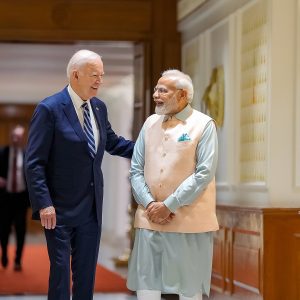by BERNARD D’MELLO

Narendra Modi, the Bharatiya Janata Party’s (BJP) foremost leader, is, as of June 9, 2024, in his third consecutive five-year term in office as India’s Prime Minister. But unlike his earlier two terms in office, when the BJP had a majority in Parliament, he now heads a coalition government. A business-as-usual line of action, however, seems to be carrying the day. The Modi regime since 2014 has unleashed what I have called semi-fascism, which has been nourishing India’s sub-imperialist tendencies.1 In this article, I try to understand sub-imperialist India’s role in U.S. imperialism’s Indo-Pacific, anti-China “pivot” project.2 (New Delhi, of course, denies any role in China’s “containment.”)
How did India emerge as a sub-imperialist power and key collaborator with the United States in the U.S. Indo-Pacific anti-China project? I suggest the answer lies in the political-economic foundations of India’s “dependent development” and sub-imperialism. Within this structural setting, India has sought to derive “national advantage” from the trade and technology wars, as well as the New Cold War unleashed by U.S. imperialism against China. Key to this process is the Quadrilateral Security Dialogue (the Quad), a strategic security dialogue between the United States, Japan, Australia, and India, paralleled by joint military exercises (named “Exercise Malabar”) of extraordinary scope. The U.S. imperialism/Indian sub-imperialism relationship has deepened following the putting in place of agreements related to consolidation of the interoperability of the U.S. and Indian armed forces. These moves are coordinated in opposition to China’s Belt and Road Initiative (BRI) and China’s presumed “String of Pearls” strategy. The reignition of hostility along the India-China border (the “Line of Actual Control,” or LAC) reflects an aspect of the relationship. Though directly antagonistic dimensions of the relationship are also present, India-U.S. relations in their entirety must be seen within “the whole,” centered on China’s resistance to U.S. imperialism.
Legacy of the British Raj: India’s 1962 China War
The British Raj (rule) left a recurring flashpoint in the Indian subcontinent in the form of ill-defined borders, and independent India has followed in its footsteps. Independent India fueled the fire of Tibetan separatism by extending help and support to Tibetans hostile to Beijing. By the 1950s, it had also claimed the territory of Aksai Chin (in 1958); insisted on complete adherence to the so-called McMahon Line; de facto junked UN Security Council Resolution 47 (adopted April 20, 1948) on the right to self-determination in Kashmir; and circumscribed—in certain aspects—the sovereignty of Nepal, Sikkim (which was eventually absorbed into India in 1974), and Bhutan.3
Monthly Review for more
